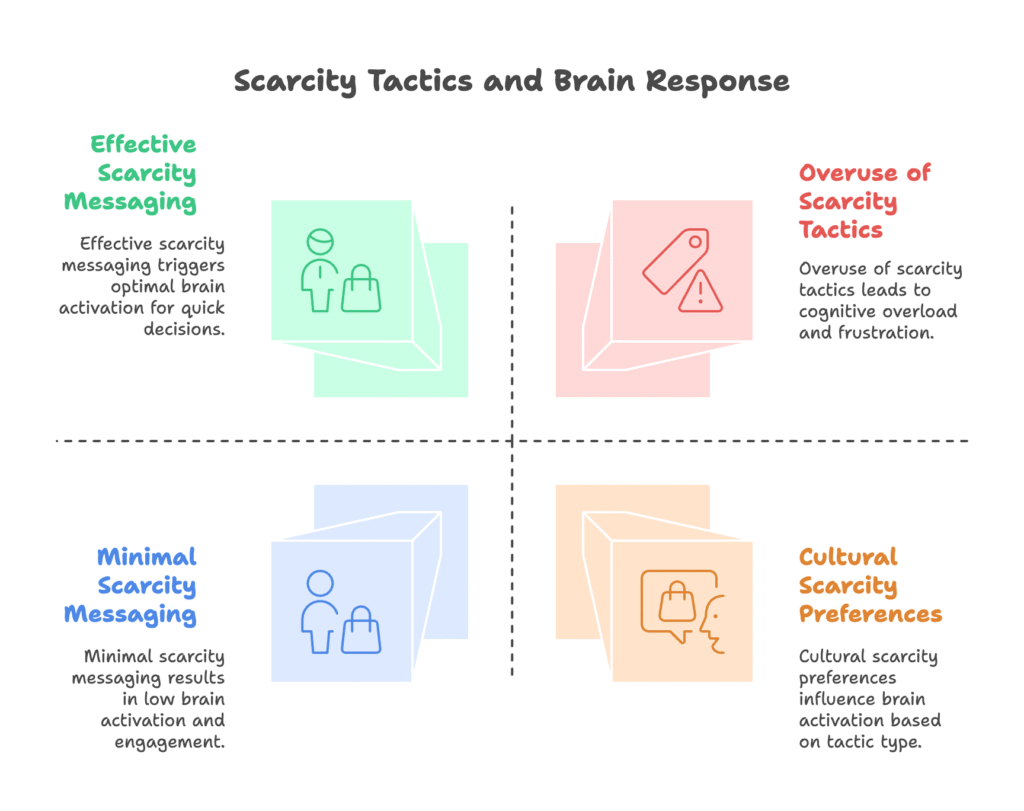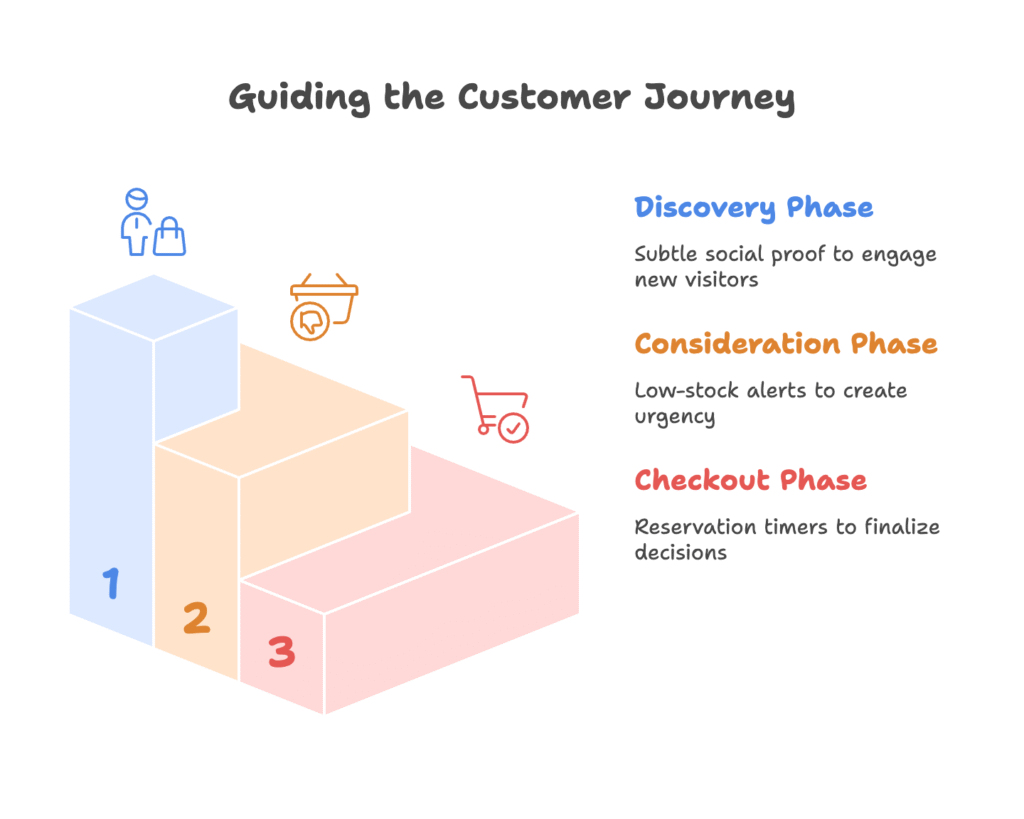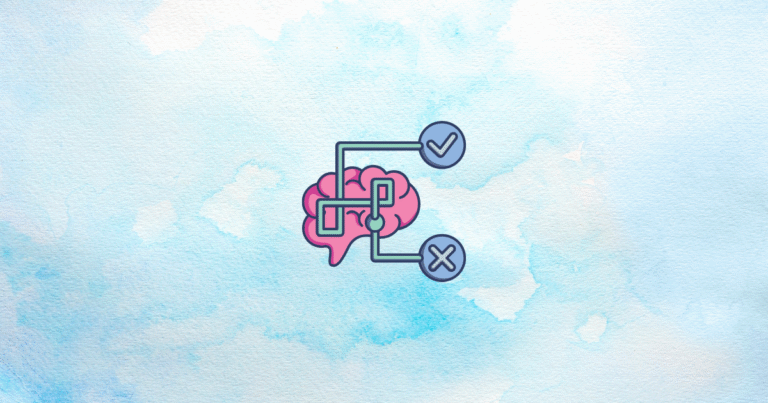The Neuroscience of Scarcity Perception
Before we jump into tactics, let’s understand what happens in your customers’ brains when they encounter scarcity messaging. This knowledge forms the foundation for everything else we’ll discuss, because effective scarcity sequencing isn’t just about what works – it’s about why it works.

Brain Regions Activated
When shoppers encounter urgency messaging, specific regions of their brains light up:
- Amygdala: This primitive part of the brain activates in response to potential loss. When customers see “Only 3 left,” their amygdala triggers a threat response – the same region that activates when facing physical danger. This creates an emotional response that can override logical decision-making.
- Ventromedial Prefrontal Cortex: This region handles value assessment during limited-time offers. It weighs the perceived value against the fear of missing out, often leading to quicker purchase decisions when scarcity is present.
- Striatum: When shoppers successfully “secure” a scarce item, their striatum releases dopamine – the feel-good neurotransmitter associated with reward. This creates a positive association with your brand and encourages repeat behavior.
Understanding these neural pathways helps explain why scarcity tactics work, but also why overusing them can backfire spectacularly. Your customers’ brains are finely tuned to detect manipulation – which brings us to our next crucial concept.
Cognitive Load Thresholds
Every shopper has a limited amount of mental energy to process information during their shopping session. Bombard them with too many urgency signals, and you’ll trigger cognitive overload – leading to frustration and abandonment. Research suggests:
- Optimal triggers per session: Most shoppers can effectively process 2-3 scarcity messages before experiencing decision fatigue. More than this can actually reduce conversion rates.
- Mobile vs. desktop differences: Interestingly, mobile users show approximately 37% higher tolerance for urgency triggers, possibly because the smaller screen creates a more focused experience.
- Cultural variations: Studies reveal significant differences in how scarcity tactics are perceived across cultures. North American shoppers generally respond better to competitive scarcity (“selling fast”), while many Asian markets show stronger response to exclusivity-based scarcity (“limited edition”).
Now that we understand what’s happening in our customers’ brains, let’s explore how to strategically sequence these triggers for maximum effect without crossing into the danger zone of scarcity fatigue. After all, understanding the brain is one thing – applying that knowledge effectively is what will set your store apart from competitors.
Strategic Sequencing Framework
Here’s where we transform neuroscience into action. The strategic sequencing framework maps specific scarcity tactics to different stages of the customer journey, creating a progression that feels natural rather than manipulative. Let’s break down how to implement this approach in your Shopify store.

Customer Journey Phases
Each phase of the shopping experience calls for different types of urgency triggers:
- Discovery Phase: When shoppers first land on your site or category pages, subtle social proof works better than aggressive scarcity. “Trending Now” badges or “Popular Choice” indicators activate mirror neurons, creating a desire to participate in what others are enjoying without triggering suspicion.
- Consideration Phase: As shoppers view specific products, low-stock alerts (like “Only 5 left”) become effective. These trigger the anterior insula – the brain region responsible for FOMO (fear of missing out) – prompting faster decision-making.
- Checkout Phase: Once items are in the cart, reservation timers (e.g., “Your cart is reserved for 15:00 minutes”) reduce prefrontal decision fatigue by creating a clear deadline for action.
The key insight here is progression – moving from subtle social influence to more direct scarcity as the customer advances through their journey. This approach respects the shopper’s decision-making process rather than short-circuiting it.
Temporal Sequencing Rules
How you time these triggers matters just as much as which ones you use:
- The 24-Hour Rule: For returning visitors, maintain at least an 8-hour gap between major scarcity triggers. This prevents perception fatigue and maintains the effectiveness of each message.
- Escalation Pattern: Follow a natural escalation sequence:
- Phase 1: Begin with social proof (“12 people bought this today”)
- Phase 2: Introduce inventory alerts (“Only 3 remaining”)
- Phase 3: Apply checkout countdowns (“Your cart is reserved for 15:00 minutes”)
- Mobile-Specific Sequencing: On mobile devices, consider:
- Vertical scroll-triggered reveals that display urgency messages as the user navigates
- Thumb-zone urgency badges positioned where users naturally interact with the screen
This structured approach ensures customers experience a natural progression of urgency rather than feeling bombarded. Remember, the goal isn’t just to create pressure, but to guide the shopping journey in a way that feels helpful rather than manipulative. Now, let’s look at how to implement these principles specifically in Shopify.
Shopify-Specific Implementation
Theory is valuable, but practical application is what will drive your results. Let’s explore how to turn these neuroscience insights into actual implementations on your Shopify store using available apps and design techniques.
App Ecosystem Integration
Shopify’s app ecosystem offers several powerful tools to implement scarcity sequencing:
- Scarcity Pro: This app can automatically adjust stock alerts based on conversion velocity. For example, if a product is selling quickly, it can dynamically lower the threshold at which “low stock” warnings appear.
- Urgency+ by Amai: Offers contextual countdowns that can be tailored to different user segments. A particularly useful feature is the ability to show shorter countdowns for mobile users, who typically have briefer browsing sessions.
- Bold Product Options: Enables dynamic variant scarcity messaging, such as “Last size M available” – a highly specific trigger that creates immediate urgency for shoppers interested in that particular variant.
The key is integration – these apps should work together rather than competing for attention. Configure them to respect the sequencing principles we’ve discussed, ensuring they trigger at appropriate points in the customer journey.
Design Guidelines
The visual presentation of scarcity triggers greatly impacts their effectiveness:
- Color Psychology:
- Use red (#FF0000) for immediate urgency situations like cart expiration
- Orange (#FFA500) works better for upcoming deadlines or moderate urgency
- Maintain consistency with your brand colors while incorporating these urgency signals
- Animation Principles:
- Implement subtle pulsation effects (about 0.8 seconds duration) for call-to-action buttons to draw attention without becoming annoying
- Use horizontal motion for countdowns to create a sense of time passing
- Ensure all animations can be paused for accessibility compliance
Remember that visual design should enhance, not overwhelm, the shopping experience. Subtle motion and strategic color use will outperform flashy, aggressive animations every time.
Ethical Safeguards
Maintaining customer trust is paramount – once lost, it’s extremely difficult to regain:
- Inventory Transparency:
- Implement real-time API stock updates to ensure accuracy
- Offer “Restock Alerts” as a positive alternative to scarcity messaging
- Never display false scarcity – customers eventually recognize patterns
- Fatigue Prevention:
- Use user-level trigger counters to track how many urgency messages each visitor has seen
- Implement session-based scarcity memory that respects the user’s previous interactions
- Allow users to dismiss certain urgency notifications if desired
Ethical implementation isn’t just about avoiding manipulation – it’s about building sustainable relationships with customers who will return again and again. Speaking of returning, how do you know if your scarcity sequencing is actually working? Let’s look at measurement and optimization techniques.
Measurement & Optimization
Implementing scarcity sequencing isn’t a “set and forget” task. To maximize effectiveness, you need robust measurement systems and a commitment to continuous optimization based on real customer behavior.
Key Metrics
Beyond standard conversion rates, several specialized metrics can help evaluate your scarcity sequencing:
- Scarcity Fatigue Rate (SFR): Track the bounce rate that occurs immediately after displaying a scarcity trigger. A spike in this metric suggests your triggers may be too aggressive or poorly timed.
- Urgency Conversion Lift (UCL): Measure the conversion increase for each specific scarcity tactic compared to a control group. This helps identify which tactics resonate most with your specific audience.
- Multi-Tactic Efficiency (MTE): Analyze how combinations of different urgency tactics perform together. Sometimes the whole is greater (or less) than the sum of its parts.
Set up these metrics in your analytics system and review them weekly. Look for patterns that indicate which combinations are most effective for your unique customer base.
A/B Testing Protocol
Systematic testing is essential for optimizing your scarcity sequencing:
- Tactic Order Variations:
- Test A: Social proof → Stock alert → Timer
- Test B: Timer → Social proof → Stock alert
Compare these sequences to determine which order creates the smoothest customer journey for your specific audience.
- Intensity Gradients:
- Test different levels of visual prominence (20% vs. 40% page coverage)
- Compare 1 vs. 3 triggers per product page to find your audience’s tolerance threshold
Run these tests with significant sample sizes (at least 1,000 visitors per variation) to ensure statistical validity. Be patient – rushing to conclusions based on limited data can lead to costly mistakes.
Neurometric Validation
For larger operations, consider advanced validation techniques:
- Eye-tracking heatmaps reveal whether your urgency elements are actually being noticed in the visual hierarchy
- EEG prefrontal load monitoring can measure actual cognitive effort required to process your page layout
- Facial coding micro-expression analysis helps identify emotional responses to different scarcity messages
While these methods require specialized equipment, even small-scale studies with 15-20 participants can yield invaluable insights not available through standard analytics. Now, let’s see how real businesses have applied these principles to achieve remarkable results.
Case Studies & Results
Theory and measurement frameworks are essential, but nothing speaks louder than real-world results. Let’s look at how actual Shopify stores have implemented scarcity sequencing to drive impressive business outcomes.
Fashion Retailer: 63% Conversion Lift
A mid-sized apparel brand implemented a strategic sequence with remarkable results:
- Sequence Implemented: They started with subtle “Trending” badges on category pages, then introduced “Last 2” alerts on product pages only for items that were genuinely limited, and finally added a 10-minute cart reservation system.
- Key Outcome: This approach led to a 41% reduction in mobile cart abandonment and a 63% overall conversion lift compared to their previous static approach.
- Customer Feedback: Post-purchase surveys revealed that customers appreciated knowing which items might sell out soon, with minimal reports of feeling pressured.
What made this implementation successful was its authenticity – scarcity signals were tied to actual inventory levels rather than appearing arbitrarily.
Electronics Store: 29% Higher AOV
An electronics retailer focused on increasing average order value through clever bundling:
- Tactic Stack: They implemented bulk discount timers (“Bundle discount available for 30:00 minutes”) combined with component scarcity messaging (“Cables frequently sell out first”).
- Result: This approach drove a 22% increase in bundle purchases and a 29% lift in average order value.
- Insight: The combination of time pressure and actual component scarcity created a compelling reason to purchase complete bundles rather than individual items.
This case demonstrates how scarcity sequencing can impact not just conversion rates but also purchasing behavior and order size.
Beauty Brand: 57% Repeat Purchase Rate
A skincare company used scarcity sequencing to focus on customer retention:
- Strategy: After initial purchase, they implemented post-purchase restock alerts for limited-inventory items and offered early access passes to new product launches for previous customers.
- Neurometric Data: Their testing showed a 33% increase in nucleus accumbens activation – the brain’s “reward center” – when customers received exclusive early access offers.
- Business Impact: They achieved a 57% repeat purchase rate, significantly above industry averages.
This example illustrates how scarcity principles can be applied beyond initial conversion to build lasting customer relationships. But implementing these tactics raises important ethical considerations – let’s address those next.
Ethical Implementation Standards
Effective scarcity sequencing must be built on a foundation of trust and transparency. Let’s examine the ethical guidelines that should govern your implementation to ensure long-term success.
Compliance Guidelines
Legal and regulatory considerations must be factored into your scarcity strategy:
- GDPR Requirements: Ensure opt-in mechanisms for persistent triggers that track user behavior across sessions. This is especially important for European customers.
- FTC Standards: Include clear disclosures for countdown timers and stock indicators. The FTC has increasingly scrutinized misleading urgency tactics.
- Dark Pattern Avoidance:
- Never implement infinite “Almost Gone!” states that don’t reflect actual inventory
- Ensure genuine inventory synchronization between your displays and actual stock
- Avoid manipulative tactics like fake customer notifications (“John in California just bought this!”)
Remember that short-term conversion gains achieved through deception will ultimately damage your brand and may expose you to regulatory action.
Accessibility Considerations
Your scarcity sequencing must work for all customers:
- Screen Reader Compatibility: Include ARIA labels for timers and dynamic elements so visually impaired customers can access the same information.
- Color Contrast: Maintain a minimum 4.5:1 contrast ratio for urgency elements to ensure visibility for those with visual impairments.
- Motion Controls: Provide options to pause or disable animations for those with vestibular disorders or sensitivity to motion.
Accessible design isn’t just ethically sound – it expands your market reach and improves the experience for all users. As we look to the future, how might scarcity sequencing evolve with emerging technologies?
Future of Scarcity Sequencing
The landscape of e-commerce urgency tactics continues to evolve rapidly. Let’s explore emerging technologies and approaches that will shape the future of scarcity sequencing.
Emerging Technologies
Several cutting-edge developments are poised to transform how we implement scarcity:
- AI-Personalized Sequences: Machine learning algorithms are now capable of adjusting triggers based on individual user tolerance and response patterns. These systems can learn which types of urgency messaging each customer responds to and adjust accordingly.
- Blockchain Inventory: Immutable scarcity verification through blockchain technology creates absolute transparency around limited-quantity items, building unprecedented trust with skeptical consumers.
- Biometric Adaptation: Early experiments with pupil dilation tracking (via webcam) allow for real-time adjustment of urgency intensity based on physiological responses, ensuring the perfect balance of motivation without overwhelming the customer.
While some of these technologies are still in their infancy, forward-thinking merchants are already experimenting with early implementations.
Predictive Models
Advanced analytics are enabling more sophisticated approaches to scarcity:
- Scarcity LTV Index (SLTV): This emerging metric evaluates how different scarcity approaches impact not just immediate conversion but lifetime customer value, allowing for more nuanced optimization.
- Cultural Sensitivity Algorithms: These systems automatically adjust scarcity tactics based on the customer’s location and cultural context, respecting different perceptions of urgency across global markets.
As these predictive models become more sophisticated, we’ll see increasingly personalized scarcity experiences that maximize conversion while minimizing customer fatigue.
In conclusion, effective scarcity sequencing represents a balanced approach to urgency marketing – one that respects customer intelligence while leveraging natural psychological responses to scarcity. By implementing these strategies thoughtfully, testing rigorously, and maintaining ethical standards, your Shopify store can achieve significant conversion improvements without resorting to manipulative tactics.
Remember: For Shopify merchants looking to implement these scarcity sequencing principles effectively, Growth Suite offers a comprehensive solution that handles visitor behavior tracking, purchase intent prediction, and targeted time-limited offers – all while maintaining brand integrity. With Growth Suite’s dynamic discount code management and high-fidelity countdown timers, you can create genuine urgency that converts browsers into buyers while building long-term customer trust.
References
- Shopify Urgency Tactics Guide
https://www.shopify.com/blog/using-scarcity-urgency-increase-sales - Neuromarketing of Scarcity (ScienceDirect)
https://www.sciencedirect.com/science/article/pii/S0022435922001237 - Cognitive Load in E-Commerce (The Good)
https://thegood.com/insights/reduce-cognitive-load/ - Global Scarcity Response Study (Tandf)
https://www.tandfonline.com/doi/full/10.1080/13527266.2022.2141297 - EEG Shopping Studies (NeuroLab)
https://neurolab.com/ecommerce-studies - GDPR Compliance for Urgency Tactics
https://gdpr-info.eu - Cultural UX Patterns (Nielsen Group)
https://www.nngroup.com/articles/cultural-ux/




